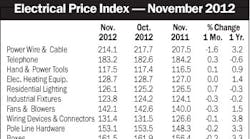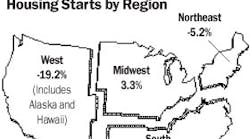Latest from Mag
People - Dec 21, 2012
Obituaries - Dec 21, 2012
November EPI Index Shows No Change
Housing Starts Dip 4% in November
Electrical Marketing - December 21, 2012
Around the Industry - Dec 21, 2012
Unusually wet weather conditions across much of the country slowed the pace of home building in September, but strong permit issuance and rising backlogs of unused permits indicate that builders are poised to pick up the pace in coming months, according to U.S. Commerce Department figures.
The government reported that housing starts declined 6 percent from the best pace of the year to a still-solid rate of 1.9 million units on a seasonally adjusted annual basis in September. Meanwhile, issuance of new permits, which can be an indication of future building activity, rose 1.8 percent to an over 2 million-unit rate, and the number of permits that have been issued but not yet used rose to the highest level since the 1970s.
“Builders would have started more homes last month, but just took a rain-check in a lot of cases,” said Bobby Rayburn, president of the National Association of Home Builders (NAHB) and a home and apartment builder from Jackson, Miss. “In fact, given all the weather-related issues in September, today’s report is pretty encouraging. We’re in good shape heading into the fourth quarter.”
The 6 percent drop in nationwide housing starts was largely attributable to a 27 percent decline in the storm-weary Northeast, where lingering precipitation saturated many building sites. Starts also declined 4.6 percent in the Midwest, 8 percent in the West and 1 percent in the South — a region that includes hurricane-battered Florida but also many other less-affected states. On the single-family side, starts fell 8.2 percent, but on the multifamily side they rose 4.7 percent.
Meanwhile, building permits for single-family homes held firm at the previous month’s impressive level, and permits for multifamily units gained 8.2 percent. Regionally, every part of the country reported gains in permits except the West, which had a marginal 1.3 percent decline.
“In terms of our housing forecast, today’s report is right on the money,” said NAHB Chief Economist David Seiders. “Every single region was up for the third quarter, and it’s now clear that housing continued to contribute to economic growth in that period. There’s also little doubt that we’re looking at another record year for single-family home building in 2004 — up about 6 percent from last year’s record, to 1.6 million units.”

